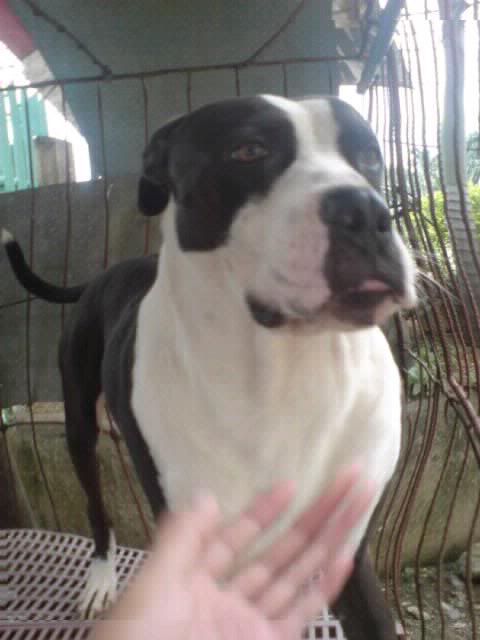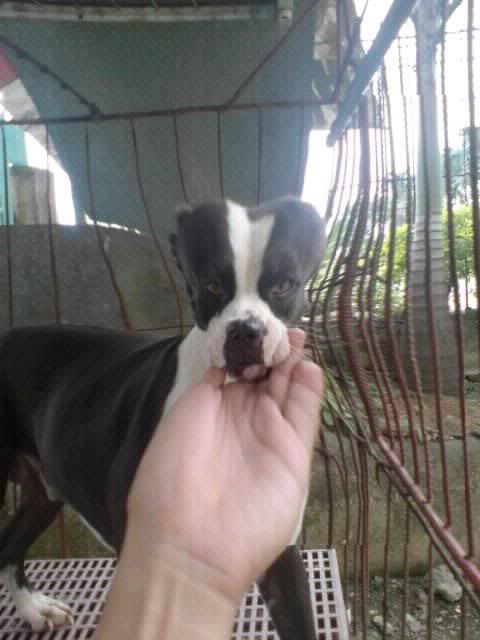up ta ni para sa mga pit lovers...
gud luck sa pet expo..
Results 691 to 700 of 1254
Thread: Be proud, be a pitbull LOVER!
-
02-09-2010, 04:42 PM #691
-
02-09-2010, 04:51 PM #692
FoR XuRe, dGHaN Jd MgA PitBuLL LoVerS MgdALa iLa iRo.......
-
02-09-2010, 06:51 PM #693
-
02-09-2010, 07:35 PM #694
Aloha share ko sa akong penanga na ero..

standard AKA: Gunner. 5 months pa cya ani

-
02-10-2010, 05:20 PM #695
karon naman gyud diay sabado ang Pet Expo noh? or Sunday ba to sa White Gold? dugaya na gyud diay nako ala ka update oi kay nabusy sa work...hayy...
-
02-11-2010, 09:03 AM #696
k rnang lay update2x bsta ang mga pets and lalabs ke d makalimtan update..hehehe
-
02-15-2010, 09:29 PM #697Junior Member

- Join Date
- Feb 2010
- Gender

- Posts
- 389
Hi...I am a pitbull lover as shown below. Meet my pack: Derrick and Chimal [both rescued from "death row" in the States], Barqs (3 y/o brindle APBT) and their "cousin" an honorary bully...Sumo the Chow-Chow! As you can see, they have been socialized since birth and honor their pack leader...me and Sumo's "parents" my nephew & niece.

-
02-16-2010, 12:01 AM #698
-
02-16-2010, 12:19 AM #699Junior Member

- Join Date
- Feb 2010
- Gender

- Posts
- 389
Want to share this article regarding tying (tethering) dogs. There was a post regarding a kennel that many admired. It really concerned me that all the dogs were tied. Kenneling a dog, regardless of breed, is a much better alternative to tying up your dog. From my experience, tying pits have caused many problems that resulted in aggression to humans. Please read this article from "Dr. Dog" an internationally re-knowned dog behaviorist.
Unchain Your Dog - Negative Effects of Tethering Dogs
By Dennis Fetko
Tying or chaining a dog (a fixed-point tether) is the single WORST way to restrain it for several reasons. (A “flying” or “rolling” tether, where the dog's primary line is attached to a second long line giving the dog lateral movement, is only marginally better and should NOT be considered a viable alternative.) Several factors influence dog bites. Tethering is PRIMARY among them. It is WRONG, BAD and results in the DEATH of many dogs and the INJURY to many humans annually. And it is TOTALLY UNNECESSARY.
* Tethering contributes strongly and directly to aggression and increases the danger to humans and animals that encounter the tied dog.
* It exposes the dog to both deliberate and inadvertent teasing by humans, animals, loud and wheeled objects (skates, skateboards, Hot Wheels, bikes, etc.) thereby conditioning very negative responses to all of these common articles.
* Dogs naturally oppose external force. Tethering triggers a built-in opposition (thigmotaxic) reflexive response inducing it to lunge toward various random stimuli simply because it is restrained.
* It introduces the pain and discomfort of the restraint into any interaction. Both pain and discomfort are common motives for aggression on their own. Added to perceived threats and thigmotaxis, they are explosive.
* It reduces the dog's territory to a minuscule size, thereby concentrating pack, den, object, territorial and food protectivity onto a single, small area.
* It mandates aberrational behavior such as being forced to unnaturally eat, sleep, play, mark and eliminate in close proximity to each other. Dogs naturally protect where they live, sleep, mark and eat. Having all concentrated in a small area markedly increases protective aggression.
* A dog has two natural responses to attack or threat: Fight or Flight. It can either run away or attack the perceived attacker; it sees no other choice to stay alive. Tethering exacerbates defensive attack aggression by obviously preventing and punishing efforts to escape but offering no protection from actual or perceived threats.
* It reinforces aggression through conditioning and learning because passersby speed up and "flee" when the dog lunges at them, thereby reinforcing the aggressive lunge by removing the “threat” more quickly.
* It increases the dog's stress by exposing it to powerful antagonistic stimuli from passing humans, dogs and other animals.
* It jeopardizes the dog's actual and perceived welfare by exposing it to attacks, accidents, direct and indirect poisoning, sick animals, mace-spraying letter carriers, etc.
Preferable options: Have the dog indoors, fence the property, or provide an outdoor run or kennel. If alternatives will not be implemented by owners, a species other than canine is indicated as a pet for that household.
The author, Dennis Fetko, Ph.D., "Dr. Dog", is a world-reknowned animal behaviorist whose accomplishments range from appearing on the 20/20 television show and managing the reintroduction of captive-bred Arabian Oryx into the Saudi Arabian National Wildlife Research Center to making a presentation at the South American Veterinary Congress. Dr. Fetko's audios and ebooks detail his fast, easy--and even fun--methods to eliminate your dog's behavior problems. Learn more at http://drdogsbehaviorsolutions.com
Article Source: http://EzineArticles.com/?expert=Dennis_Fetko
-
02-16-2010, 04:10 PM #700
Advertisement
Similar Threads |
|





 Reply With Quote
Reply With Quote



